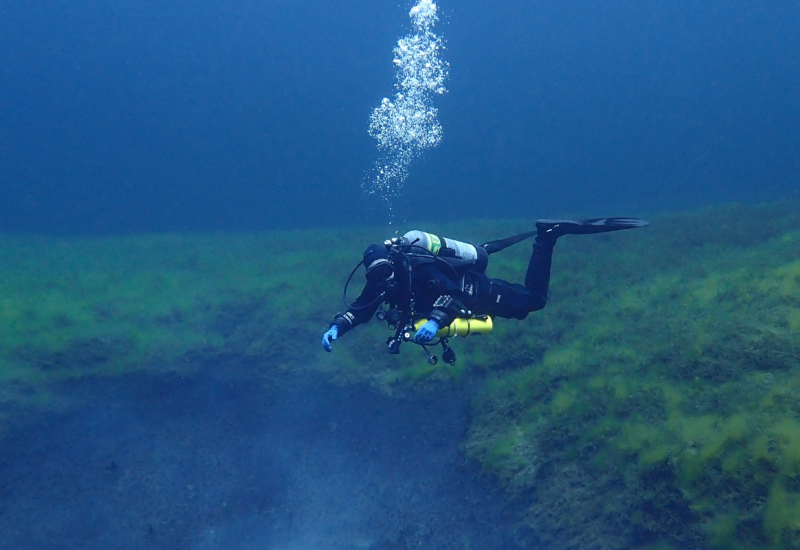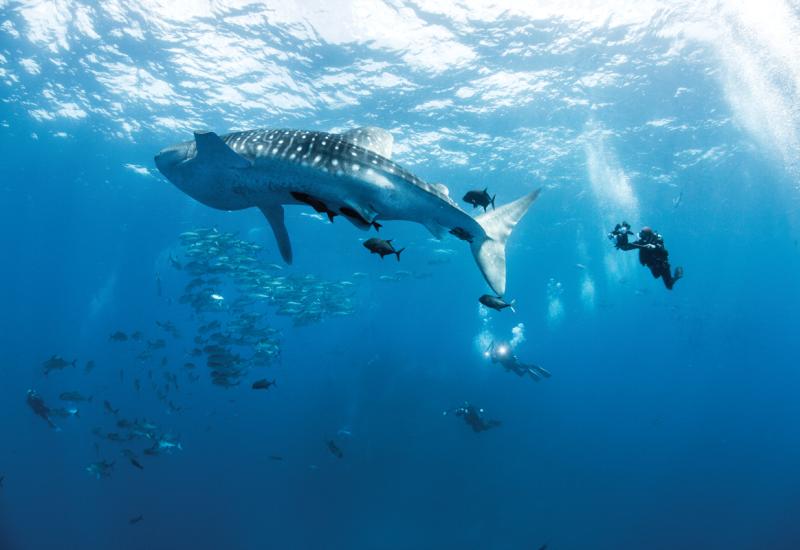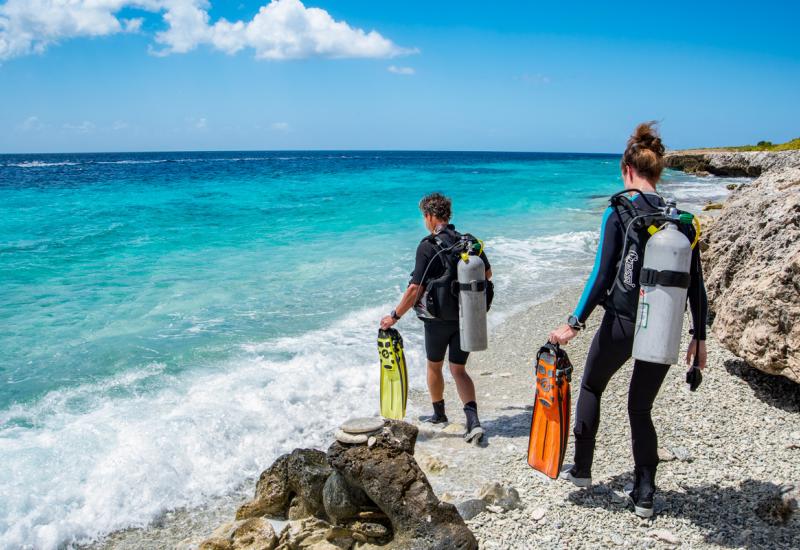Instruction: CNS Oxygen Toxicity
Oxygen physiology for divers has been one of the most misunderstood subjects in the sport for some time. Case in point: For years, the oxygen percentage in atmospheric air was commonly taught in scuba classes to be 20 percent when it actually is 20.98 percent, rightfully rounded to 21. What's the big deal about a lousy 1 percent you say?
Well, for example, it throws off all the computations for maximum operating depths for nitrox mixes or even regular compressed air if you're going deep. More important, such slack observance of oxygen percentages contributes to a pattern of sloppy information and what President George W. aptly calls "fuzzy math."
As recreational divers we must be concerned with the effects of elevated partial pressures of oxygen that occur as we descend in the water column. Remember, it's the partial pressure of oxygen (PO2) that is most critical, not the percentage of oxygen in the gas you breathe.
Little Physics, Less Math
Quick review of Dalton's Law from your initial certification class. The total pressure exerted by a gas mixture is equal to the sum of the partial pressures of the different gases in the mix. Mathematically, this is expressed as P = P1+P2+P3, where "P" refers to total pressure, and "P1" is the partial pressure of, for example, nitrogen and "P2" is the partial pressure of oxygen, and so on.
You'll also recall that as depth increases, so does partial pressure. This is especially important when it comes to oxygen, which becomes increasingly toxic as its partial pressure increases beyond the normal .21 we are adapted to at the surface. Fortunately, most texts that teach nitrox also provide convenient tables that allow you to look up various partial pressures of oxygen at varying depths based on the percentage of oxygen in your mix. Some dive computers also do it for you. Not only is this convenient, it also eliminates potentially hazardous math errors.
The Hazard
The central nervous system (CNS) is most susceptible in the kind of diving most sport divers do: relatively short but potentially high PO2 exposures. Although the exact physiological process is still not fully understood, predictable results will follow if oxygen limits are exceeded. Even a cursory examination of these effects (see above) should illustrate the seriousness of a CNS-O2 hit in deep water. The onset and severity of symptoms do not follow any particular pattern and may vary in an individual diver from day to day. Of particular note is that there may not be less serious symptoms to serve as a warning before a full convulsion is precipitated. According to oxygen physiologists Stephen Thom and James Clark, "Minor symptoms did not always precede the onset of convulsions, and even when a preconvulsive aura did occur, it was often followed so quickly by seizures that it had little practical value."
Many divers have relied on the incorrect supposition that lip twitching or eye tics would provide adequate notice of impending disaster. This supposition has been disproved by chamber tests and direct observation in actual dive scenarios. Oxygen convulsions, per se, are not inherently harmful. But imagine the implications for an untended diver or even one with a buddy nearby. Management of an airway and rescue in such an extreme situation is nearly impossible, and the diver will almost certainly drown.
Managing Oxygen Exposure
What is an appropriate limit for PO2? In 1971 when I worked on Navy diving projects, the limit was commonly accepted to be 2.0 ATA (atmospheres absolute). Over the years, this has been reduced to the nearly universal recommendation now of 1.6 ATA (132 fsw for Nitrox 32). Yes, you have probably read about other recommendations to keep your PO2 under 1.4 or even 1.3. While you can apply degrees of conservatism to anything, there have been no incidents of oxygen toxicity at 1.6 when time limits were properly observed. The DAN Nitrox Workshop held in November 2000 concluded that a PO2 of 1.6 was an appropriate operational limit for sport divers, hopefully ending an ongoing controversy.
However, it is important to understand that the partial pressure of oxygen only makes up part of the equation for an oxygen "dose," the common way to refer to your total exposure. The other variable is time, usually expressed in minutes at a particular PO2. NOAA has published a table that serves as a quick reference for divers to plan exposures.
I'm Just Joe Diver, Not a Tech Gorilla
While the potential hazard of CNS oxygen toxicity cannot be underestimated, the good news is that the risk to sport divers is very limited when the NOAA limits are observed. As noted before, there has never been a sport diving oxygen incident within the NOAA limits.
Oxygen dose is also sometimes referred to as the "oxygen clock," a reasonable nickname since it implies time limits associated with PO2. Your nitrox dive computer should store this information in its memory (along with changeable PO2 settings) and calculate your exposure automatically. Your exposure is usually expressed as a percentage of the maximum dose rather than a countdown in minutes such as you may be used to with bottom time remaining.
If your diving practice is to avoid decompression, you will find that you will never approach the CNS dose limits because your no-deco time limit will occur first. Since most divers tend to dive in multilevel profiles and don't spend the entire dive at the maximum PO2, the actual oxygen clock rarely reaches 20 percent of the dose limit.
Please note: There is no more danger with a 50 percent exposure to oxygen at 1.6 than there is with a 50 percent exposure at 1.4 or 1.3. It's the total dose, not the PO2 that determines your risk factor.
Other Risk Factors
We know that susceptibility to oxygen toxicity is increased by other factors. These include elevated carbon dioxide levels within the diver, often found in hard working conditions. Although sport divers typically do not approach the exertion levels of actual working divers for which the NOAA limits were defined, sport divers can be exposed to prolonged swimming efforts and cold water, which can be risk factors.
Many overly shrill cautions about reducing PO2s come from those who have an incomplete understanding of how divers actually dive. Most swim lazily around the reef or wall, stopping to take photos or simply take in the sights. The most active part of the dive usually occurs at the beginning or end where some higher swimming exertion happens in the process of descent against a current, traveling to a starting point, or swimming back to the boat or shore. Divers, as a population, really don't work very hard.
Be advised, however, that your PO2s will need to be lowered if your dive plan will exceed 45 minutes at 1.6 ATA. Then it is a simple matter of shifting to 1.5 on your computer, which allows two hours of exposure on a single dive. Most divers will never experience such lengthy exposures unless on deep technical dives followed by prolonged decompression on pure oxygen or 80/20 nitrox. Rebreather divers can also place themselves in long dive profiles that dictate a lesser PO2, but for divers on single-cylinder, open-circuit scuba, it is virtually impossible to reach the time limits.
Conclusion
The hazards of CNS oxygen toxicity are easily avoided by ensuring that your dive profiles don't violate the NOAA limits. Set your PO2 at 1.6 (less for longer dives), watch your computer's display of dose accumulation, and do not exceed the maximum depth limit for your nitrox mix.
Signs and Symptoms of CNS Oxygen Toxicity
-
Facial pallor
-
Sweating
-
Bradycardia (slowness of the heart rate)
-
Palpitations
-
Depression
-
Apprehension
Visual symptoms
-
Dazzle
-
Constriction of visual field
-
Tinnitus and auditory hallucinations
-
Vertigo
-
Respiratory changes
-
Nausea
-
Spasmodic vomiting
-
Fibrillation of lips
-
Twitching of lips, cheeks, nose or eyelids
-
Syncope (fainting)
-
Convulsions
| NOAA PO2 and Exposure Time Limits for Working Divers | |||||||||||||||||||||||||
| Oxygen Partial Pressure (PO2) in ATA | Maximum Duration for Single Exposure in Minutes | Maximum Total Duration/24 Hr. Day in Minutes | |||||||||||||||||||||||
| 1.6 | 45 | 150 | |||||||||||||||||||||||
| 1.5 | 120 | 180 | |||||||||||||||||||||||
| 1.4 | 150 | 180 | |||||||||||||||||||||||
| 1.3 | 180 | 210 | |||||||||||||||||||||||
| 1.2 | 210 | 240 | |||||||||||||||||||||||
| 1.1 | 240 | 270 | |||||||||||||||||||||||
| 1.0 | 300 | 300 |
Oxygen physiology for divers has been one of the most misunderstood subjects in the sport for some time. Case in point: For years, the oxygen percentage in atmospheric air was commonly taught in scuba classes to be 20 percent when it actually is 20.98 percent, rightfully rounded to 21. What's the big deal about a lousy 1 percent you say?
Well, for example, it throws off all the computations for maximum operating depths for nitrox mixes or even regular compressed air if you're going deep. More important, such slack observance of oxygen percentages contributes to a pattern of sloppy information and what President George W. aptly calls "fuzzy math."
As recreational divers we must be concerned with the effects of elevated partial pressures of oxygen that occur as we descend in the water column. Remember, it's the partial pressure of oxygen (PO2) that is most critical, not the percentage of oxygen in the gas you breathe.
Little Physics, Less Math
Quick review of Dalton's Law from your initial certification class. The total pressure exerted by a gas mixture is equal to the sum of the partial pressures of the different gases in the mix. Mathematically, this is expressed as P = P1+P2+P3, where "P" refers to total pressure, and "P1" is the partial pressure of, for example, nitrogen and "P2" is the partial pressure of oxygen, and so on.
You'll also recall that as depth increases, so does partial pressure. This is especially important when it comes to oxygen, which becomes increasingly toxic as its partial pressure increases beyond the normal .21 we are adapted to at the surface. Fortunately, most texts that teach nitrox also provide convenient tables that allow you to look up various partial pressures of oxygen at varying depths based on the percentage of oxygen in your mix. Some dive computers also do it for you. Not only is this convenient, it also eliminates potentially hazardous math errors.
The Hazard
The central nervous system (CNS) is most susceptible in the kind of diving most sport divers do: relatively short but potentially high PO2 exposures. Although the exact physiological process is still not fully understood, predictable results will follow if oxygen limits are exceeded. Even a cursory examination of these effects (see above) should illustrate the seriousness of a CNS-O2 hit in deep water. The onset and severity of symptoms do not follow any particular pattern and may vary in an individual diver from day to day. Of particular note is that there may not be less serious symptoms to serve as a warning before a full convulsion is precipitated. According to oxygen physiologists Stephen Thom and James Clark, "Minor symptoms did not always precede the onset of convulsions, and even when a preconvulsive aura did occur, it was often followed so quickly by seizures that it had little practical value."
Many divers have relied on the incorrect supposition that lip twitching or eye tics would provide adequate notice of impending disaster. This supposition has been disproved by chamber tests and direct observation in actual dive scenarios. Oxygen convulsions, per se, are not inherently harmful. But imagine the implications for an untended diver or even one with a buddy nearby. Management of an airway and rescue in such an extreme situation is nearly impossible, and the diver will almost certainly drown.
Managing Oxygen Exposure
What is an appropriate limit for PO2? In 1971 when I worked on Navy diving projects, the limit was commonly accepted to be 2.0 ATA (atmospheres absolute). Over the years, this has been reduced to the nearly universal recommendation now of 1.6 ATA (132 fsw for Nitrox 32). Yes, you have probably read about other recommendations to keep your PO2 under 1.4 or even 1.3. While you can apply degrees of conservatism to anything, there have been no incidents of oxygen toxicity at 1.6 when time limits were properly observed. The DAN Nitrox Workshop held in November 2000 concluded that a PO2 of 1.6 was an appropriate operational limit for sport divers, hopefully ending an ongoing controversy.
However, it is important to understand that the partial pressure of oxygen only makes up part of the equation for an oxygen "dose," the common way to refer to your total exposure. The other variable is time, usually expressed in minutes at a particular PO2. NOAA has published a table that serves as a quick reference for divers to plan exposures.
I'm Just Joe Diver, Not a Tech Gorilla
While the potential hazard of CNS oxygen toxicity cannot be underestimated, the good news is that the risk to sport divers is very limited when the NOAA limits are observed. As noted before, there has never been a sport diving oxygen incident within the NOAA limits.
Oxygen dose is also sometimes referred to as the "oxygen clock," a reasonable nickname since it implies time limits associated with PO2. Your nitrox dive computer should store this information in its memory (along with changeable PO2 settings) and calculate your exposure automatically. Your exposure is usually expressed as a percentage of the maximum dose rather than a countdown in minutes such as you may be used to with bottom time remaining.
If your diving practice is to avoid decompression, you will find that you will never approach the CNS dose limits because your no-deco time limit will occur first. Since most divers tend to dive in multilevel profiles and don't spend the entire dive at the maximum PO2, the actual oxygen clock rarely reaches 20 percent of the dose limit.
Please note: There is no more danger with a 50 percent exposure to oxygen at 1.6 than there is with a 50 percent exposure at 1.4 or 1.3. It's the total dose, not the PO2 that determines your risk factor.
Other Risk Factors
We know that susceptibility to oxygen toxicity is increased by other factors. These include elevated carbon dioxide levels within the diver, often found in hard working conditions. Although sport divers typically do not approach the exertion levels of actual working divers for which the NOAA limits were defined, sport divers can be exposed to prolonged swimming efforts and cold water, which can be risk factors.
Many overly shrill cautions about reducing PO2s come from those who have an incomplete understanding of how divers actually dive. Most swim lazily around the reef or wall, stopping to take photos or simply take in the sights. The most active part of the dive usually occurs at the beginning or end where some higher swimming exertion happens in the process of descent against a current, traveling to a starting point, or swimming back to the boat or shore. Divers, as a population, really don't work very hard.
Be advised, however, that your PO2s will need to be lowered if your dive plan will exceed 45 minutes at 1.6 ATA. Then it is a simple matter of shifting to 1.5 on your computer, which allows two hours of exposure on a single dive. Most divers will never experience such lengthy exposures unless on deep technical dives followed by prolonged decompression on pure oxygen or 80/20 nitrox. Rebreather divers can also place themselves in long dive profiles that dictate a lesser PO2, but for divers on single-cylinder, open-circuit scuba, it is virtually impossible to reach the time limits.
Conclusion
The hazards of CNS oxygen toxicity are easily avoided by ensuring that your dive profiles don't violate the NOAA limits. Set your PO2 at 1.6 (less for longer dives), watch your computer's display of dose accumulation, and do not exceed the maximum depth limit for your nitrox mix.
Signs and Symptoms of CNS Oxygen Toxicity
Facial pallor
Sweating
Bradycardia (slowness of the heart rate)
Palpitations
Depression
Apprehension
Visual symptoms
Dazzle
Constriction of visual field
Tinnitus and auditory hallucinations
Vertigo
Respiratory changes
Nausea
Spasmodic vomiting
Fibrillation of lips
Twitching of lips, cheeks, nose or eyelids
Syncope (fainting)
Convulsions
||||||||||||||||||||||||||| |---|---|---|---|---|---|---|---|---|---|---|---|---|---|---|---|---|---|---|---|---|---|---|---|---|---|
|| NOAA PO2 and Exposure Time Limits for Working Divers| | Oxygen Partial Pressure (PO2) in ATA| Maximum Duration for Single Exposure in Minutes| Maximum Total Duration/24 Hr. Day in Minutes| | 1.6 | 45 | 150 | | 1.5 | 120 | 180 | | 1.4 | 150 | 180 | | 1.3 | 180 | 210 | | 1.2 | 210 | 240 | | 1.1 | 240 | 270 | | 1.0 | 300 | 300 | |










